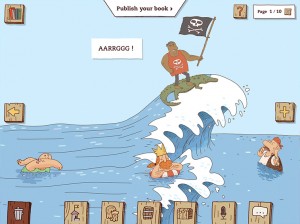
For several years now, children’s literature has been venturing step by step into the digital field, with all the creative force and originality that the domain has shown itself capable of. Beyond the simple digitalization of content in PDF or E-pub format, many producers (Nosy Crow, Tank & Bear, Camera Lucida, Atomic Antelope, and Moobot Studio, to name just a few) are embarking today into digital storytelling and using it to its full potential. The development of immersive environments, auditory and visual adjuncts, interactive features; animation; integrated mini-games, transmedia conceptualization, geolocation, chronolocation, augmented reality, linked objects, and interactive installations are now opening up a whole range of possibilities for narrative construction. And the potential for exploration is still great: tablets that make it possible to create texture, interactive fabrics, virtual reality, 3D printing… These are just a few of the hundreds of innovations that could integrate themselves into the construction of a digital story.
The development of this type of project, still at a very organic stage, is turning the creative process, both individual and collaborative, on its head. The various players involved (authors, illustrators, publishers, as well as narrative architects, designers, developers, musicians, animators and others) are gradually starting to identify the components and boundaries of their respective roles, learning to work within group dynamics and with collaborators that were unknown to them in their earlier productions. To be able to bring forward a coherent work and a relevant narrative structure, each of these players must not only deal with other creators but must also anticipate in advance the potential of technology and the impact of integrating it into the story. With the constant back and forth on content elements between the various areas of expertise, the creative timeline becomes more blurred, the teams become bigger and more collaborative, and the work structure becomes more complex. New roles also emerge: the narrative architect, in particular, is essential to the consistency of the experience, assuming a place at the center of the creative process, a role previously reserved for the author.
In the realm of children’s literature, the work is perhaps even more complex: the age, level of understanding and literacy skills of the intended audience influence the design of the narrative structure and often require bringing in another range of collaborators from the education field. Producers-publishers, creators and researchers must work together to ensure that the proposed features, story structure and navigational aids, among others, are suitable for use by young readers.
Implementing this type of project draws on the three basic multimodal media literacy skills: information skills, aimed at using effective search strategies and analyzing, organizing and critiquing information sources; technical skills, focused on learning how to operate and use technology tools; and multimodal skills, dealing with the ability to read and communicate by effectively combining at least two methods such as writing (textual means), image (visual means), audio (sound means) and movement (kinetic means, using a click or tactile interaction) on varied media (Lebrun, Lacelle & Boutin, 2012).

As the media environment in which we are evolving becomes more and more complex and multimodal, it seems vital today to equip children with tools to help them decode and produce such messages in order to become enlightened and critical adults, able to inform themselves properly and create on their own. This is where analyzing and documenting creative processes especially become an issue: by integrating creative activities inspired by those working in the field into the curricula, from narrative design to final composition, we will help them acquire skills in an environment in which very few tools are available.
The series of apps for tablets developed by La boîte à pitons, Fonfon interactive, in collaboration with publisher of children’s books Fonfon and the Akufen studio, with the pedagogical input of education specialists of the Université du Québec à Montréal, fits directly into this thinking. Each app offers not only a multimodal interactive book that associates visuals, text, animation, sound effects and optional readalong pre-recorded narration but also, and especially, a creative platform that allows young users to create their own book of a dozen pages by drawing on a bank of visuals taken from the book (decors, characters and objects), recording their voice and adding their own text. By remaining within a known and limited context (the visual world of the book that they have just read), the children are guided in using various media and, as part of a collective process, creating in a collaborative and structured way.
After several weeks of testing, we are thrilled with what we have been able to observe. As the testing progresses, the methods are naturally refined: the story’s characters and major milestones define themselves collectively early on, rather than during the creative process; the creative timeline defines itself; teams form based on the creative roles (author, narrator, designer, publisher), the reader’s experience is anticipated; and the technological barriers (maximum number of characters, recording time limit) are used to produce a coherent construction.
Every day we learn something new from our observations. We are convinced more than ever that children will acquire the skills they need to evolve in today’s multimedia world through “doing.”
One story at a time!
 Prune Lieutier is a co-founder and the development director of La boîte à pitons, a young Montreal-based company that designs, develops and markets interactive digital experiences that entertain and enrich young audiences, their parents, and their teachers. She’s also a PhD student at the University of Québec in Montréal focusing on new models of creation involved in digital children’s books and their possible adaptation in pedagogical contexts.
Prune Lieutier is a co-founder and the development director of La boîte à pitons, a young Montreal-based company that designs, develops and markets interactive digital experiences that entertain and enrich young audiences, their parents, and their teachers. She’s also a PhD student at the University of Québec in Montréal focusing on new models of creation involved in digital children’s books and their possible adaptation in pedagogical contexts.

